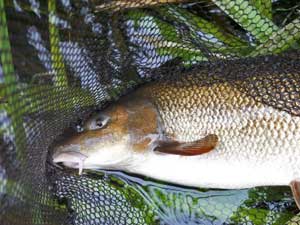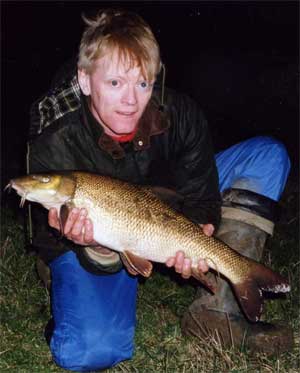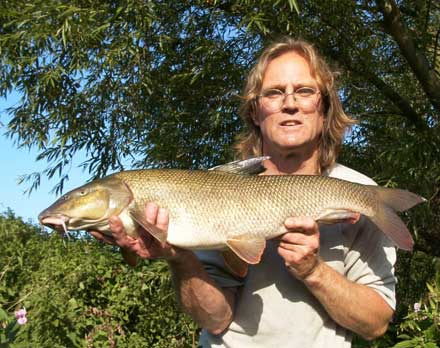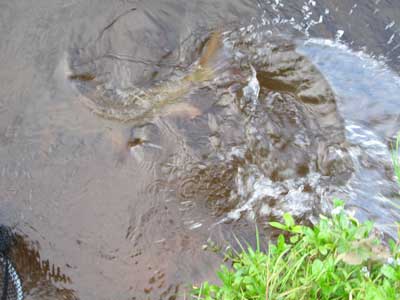The ‘do’s’ and particularly the ‘don’ts’ about catching big barbelI’ve been thinking about this article for a while. It probably started when a highly competent angler asked me for advice on how to catch his first double figure barbel.
John is about the same age as me and has been fishing the Yorkshire rivers for barbel since he was a lad. He fishes the same stretches as me, uses much the same tackle, and much the same bait so why isn’t he catching big fish as consistently as me? The only thing I could suggest was that we have a day on the river together and see if we were doing anything different. We haven’t managed to get together yet, but my interest was piqued and I started to observe my fellow barbel anglers more closely. It soon became obvious that we do things that are supposed to catch us more fish: buy the latest gear, use the latest rigs, use the latest super baits. What we don’t do is think about what might prevent us from catching a fish. So this article is more about what not to do than what to do. In my opinion doing this (or not doing it, if you see what I mean!) will catch you more, and bigger, fish. You may not agree with me, but give it a try and see what happens. What is a big barbel?If you look at the reports in the angling press you might be forgiven for thinking that a big barbel was a fish of 14lb or bigger. This of course is cobblers. You’ll also hear tales of loads of doubles from almost any river you care to ask about. Again this is cobblers as these leviathans are very rarely weighed and the anglers who catch them have no idea of how big a 10lb barbel actually is. For the purposes of this article let’s call a big barbel one of over 9lb. Most people should be in with a chance of catching at least one fish of this size per season. The challenge is to increase the number of fish over 9lb that you catch – let’s say that a challenging target is that more than 5 percent of the barbel you catch should be over 9lb. Just for information, at the time of writing this I’ve had 25 barbel this season so far and 2 have been over 9lb. Midterm verdict: Meeghan is obviously practising what he preaches!
Now those of you in the frozen North might cry foul: those southern jessies have it easy and 15lb barbel are queuing up to be caught. In fact the challenge is much the same for everyone. There might be a few more 9lb plus barbel in some rivers in the South, but I’d lay some money that the difference is almost undetectable by looking at the average angler’s catch stats. So…. The target stays at 9lb, but if you want to make life more difficult increase your personal target to 9lb 8oz or increase the percentage of 9lb plus fish. So how are we going to do it?Ah, the $64,000 dollar question – and it’s not a simple one to answer! There are 2 main requirements for catching a big fish the first is to locate it and the second is to present a bait to it without scaring it. So the secret of catching more big fish is to find them and not to frighten them. That’s it then, job’s a good ‘un! Of course it’s never as simple as that. Big fish are thinner on the ground than average sized fish and not every swim will contain them. Big fish are by nature more cautious than average sized fish: they may have been caught before, they will almost certainly have seen other fish being caught, they will be so much more experienced than smaller fish. You’re never going to be certain that you’ll catch your biggie, so the best you can hope for is to increase the chances of doing so. What I’m going to do is give you a strategy for catching bigger barbel. You can develop it further yourself if you like, but if you adopt some of the strategies outlined below I’ll guarantee that you’ll catch bigger fish.
Remember I said that big fish are more cautious than smaller fish? That’s another way of saying that they are more easily scared. But it’s not just one thing that scares a fish and stops it taking your bait, it’s usually a combination of factors. Think of it as a score card: award one point for each factor that might scare a fish (one for movement on the skyline, one for your line being visible, one for falling in as you arrive…. You get the picture?). Each fish has a fear threshold above which it won’t take your bait. For example if you’re racking up 8 scare points and a fish has a scare threshold of 6 points you’re going to spook it and it won’t take your bait. Because big fish are generally more wary than small fish they will have a lower threshold. This explains how we develop bad fishing habits as we will probably still catch fish even though we are scaring some of the more cautious fish. We can go home thinking we’ve had a great day when in fact we’ve scared away the fish of a lifetime! So let’s look at a list of things that will stop a fish taking your bait. Understanding the Barbel In order to increase our success rate we need to have a basic understanding of our quarry. Traditionally at this point, angling authors attempt to teach watercraft and you get lots of nice diagrams showing where fish might be found. To be honest, nobody has done it better than Bernard Venables did in Mr Crabtree so if you want that kind of stuff have a look at your own copy or go and get one on E-bay. Failing that, John Wilson does a good job in ‘Catch Barbel’. My aim here is to give you a simple tool kit to enable you to catch bigger barbel and to do this we’ll concentrate on what makes a big barbel different from a small barbel. I suppose it’s an obvious statement that bigger barbel are older barbel and, as we’ve already said, older fish are more cautious. They will have all the natural caution of their younger brethren, but they will also have experience – they will have survived all sorts of threats and dangers from attacks by pike and otters through to being caught by anglers. As a result they will have developed behaviours that reduce the risk. We anglers are major contributors to this educative process and in the more heavily fished stretches it sometimes seems that we’re in a mini-arms race with our quarry. The more fish are caught the more educated they become and so the harder we have to work to catch them. Educated fish develop strategies to test situations that they are suspicious of. They may enter a swim in such a way that they can see any potential danger. For example I’ve seen large barbel swim round a bed of pellets and enter the area from upstream – are they looking for line? Fish aren’t intelligent. They can’t reason and they learn by trial and error. A good example of this is the hair rig. Why does it work? The hook couldn’t be more obvious, yet nearly every large carp, bream, tench and barbel is caught on the hair. This is because the fish can’t make the connection between the hook and the bait – it just doesn’t have the mental capacity to do so. So your biggest weapon is your ability to reason. Look at what other anglers are doing – are they all fishing in much the same style? It doesn’t take a big change to tilt the odds back in your favour so keep it simple, make subtle changes and minimise the scare factor. Barbel detect danger through their senses. As anglers the main fishy senses we have to worry about are hearing (or detecting vibration), sight and feel. Fish will be frightened on two basic levels. The first is if they detect something unnatural or outside their normal experience. They will treat this with caution until they have worked out whether it is a threat or not. The second is if they detect something that they associate with danger such as the noise of a lead hitting the water, the glint of a hook on the bottom or the feel of taut mono as they brush against it. The more we minimise the possibility of a fish detecting a danger signal the less likely we are to spook it. The other factor that affects whether or not a fish might take our bait is hunger. OK, it’s fairly obvious that if a fish isn’t hungry it won’t eat, but do you feed your swim like you believe that? I see so many people arrive at the river with a large bucket of pellets and proceed to feed most of them during a session. That might be OK on a lightly fished stretch, but if several anglers are all doing the same thing then a huge quantity of bait is entering the river. I know it was usual to feed large quantities of maggots and hemp a few years ago, but maggots are mostly water and hemp has little food value. If a fish enters your swim and isn’t really hungry it might still pick up a small quantity of bait. If you’ve just fed 2 kg of pellet the chances of that small quantity containing your hook bait is pretty slim. A small quantity of bait will still attract fish, is less likely to spook them and increases the chance of your hook bait being taken by a wary fish. The AnglerAs an angler you are at the top of the food chain and even if you return every barbel you catch you are still effectively a predator. Once you have caught a fish you return it by choice, but you could if you wished kill it and eat it (that should get me in trouble with the barbel police!). Fish view us as predators so it’s important that they don’t become aware of our presence. Because fish are not at the top of the food chain and some of their predators strike from above their instincts are to flee when they see any movement above them. A dark form silhouetted against a bright sky or bright clothes against a dark background are easily seen and any movement will then cause fish leave the area. You don’t need to creep around or to wear full camou, you just need to be aware when crossing the skyline and wear subdued clothing.
The only other things that can give our presence away are noise and vibration. In water noise and vibration are one and the same so I’ll treat these as one subject. Fish can certainly hear sounds: try clapping your hands and watching the reaction of fry in the margins. Voices probably aren’t easily distinguished from the general background noises provided you don’t shout. Vibrations are the killer: heavy footsteps or dropping heavy items of tackle announce your presence unmistakably. The final factor is your attitude. If you don’t believe that you’re going to catch a big fish then you probably won’t. You need to have confidence in your tackle, your method and your bait. Equally you need to be willing to change and to try new swims and new methods. You don’t catch fish if you’re at home in front of the telly so sometimes it’s just a question of sticking at it – no matter how bad the conditions there’s always a chances of a fish and often the big fat ones are the last to stop feeding. Adequate TackleIt goes without saying that your tackle must be capable of landing every barbel that you hook. This means balanced tackle – it’s pointless using 10lb line with a medium feeder rod. You’d think that this would be obvious, but I’ve lost count of the 5lb barbel I’ve caught with hooks in their mouths. I use a 1.5lb test curve rod with 10lb or 12lb line for most of my fishing. I prefer a braid hooklength, but if there is weed about then I always use a mono hooklength.
Your tackle must also be capable of getting your bait to where the fish are. If you can’t Wallis cast then your beautifully engineered centrepin is going to restrict you to fishing close to your side of the river. In flood conditions your rod must be capable of casting the heavy leads required to hold out in the flow. RigsThere’s a lot of nonsense talked about rigs. There are only three important things that a barbel rig should offer: it should hook the fish reliably, it should be tangle free and it should be inconspicuous. In my opinion this last is where most people go wrong. Surely it’s obvious that the more conspicuous your rig the more it is likely to spook the fish? You’d think so wouldn’t you, but just look at the standard set-up of most barbel anglers: rods pointing skywards with line tight to a large lead; a short hooklength of some curly stiff stuff with perhaps the last inch or so being limp and flexible; a large shiny hook lying next to your bait. Of course none of us lot fish like that do we? So let’s start again and think about this logically. What we’re trying to do is to make our tackle as inconspicuous as possible and thus spook as few fish as possible. Fish have 3 ways (I’m discounting smell) of detecting our rigs: vibration (sound), sight and feel. Vibration: this can be the most difficult thing to overcome. We can be quiet on the bank, but unless we can lower our bait into the water we have to cast. Fish in heavily fished stretches will associate the sound of a lead or feeder hitting the water with danger. Heavy loose feeding might also have an adverse effect as Mrs Barbel might associate the noise of this with the presence of a baited hook. So what do we do? Well we have two options. The first is to change the ‘signature’ of our rig hitting the water. You can do this by using the lightest bomb possible, I often use 1/8 oz bombs, or by using a string of swan shot. Additional weight for casting can be a ball of paste wrapped round the hook bait or a pva bag of freebies. The second is to cast as little as possible – get as much feed as you need in early in the session then wait for the fish to return. Regular casting might catch you more fish, but they are likely to be smaller fish. The effectiveness of bait and wait tactics is largely due to the fish being allowed time to recover from disturbance and begin to feed confidently. |
Welcome!Log into your account















